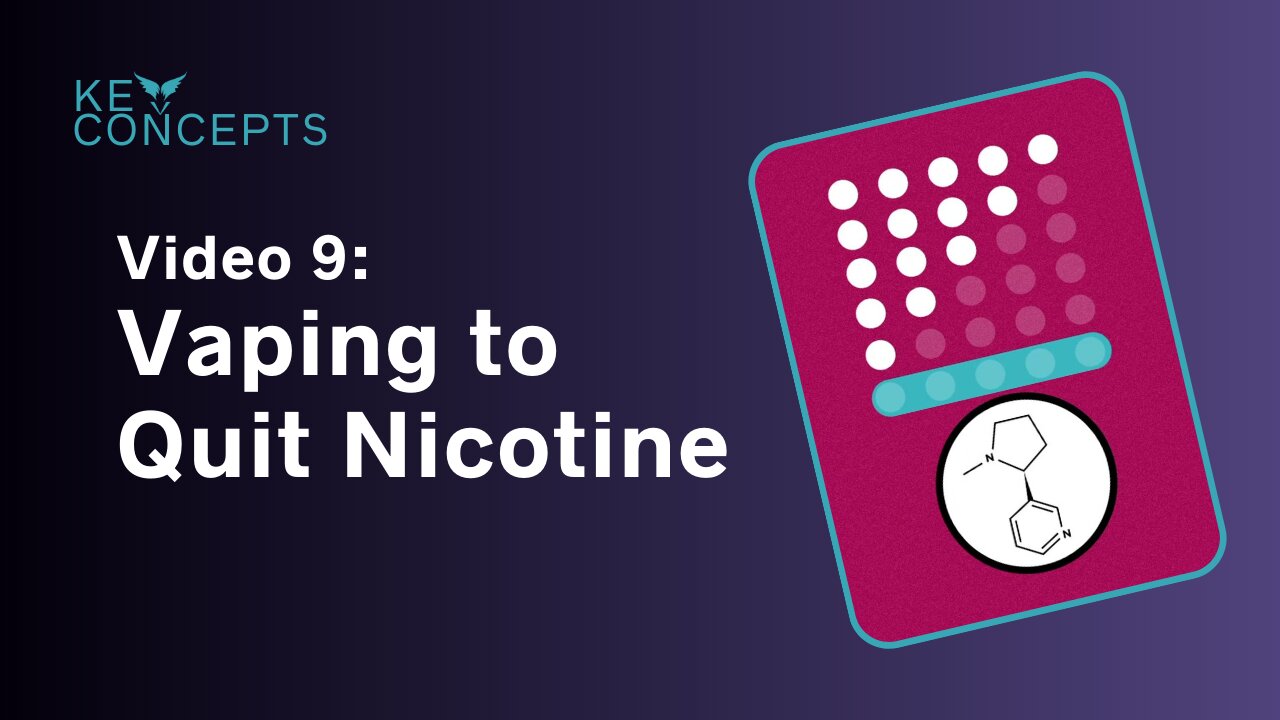Premium Only Content

VAEP Key Concepts Video 9: Vaping to Quit Nicotine
Did you know that vaping can be used to stop smoking AND wean off nicotine in just 4 stages?(1)
In the first stage, the smoker dual uses which means they continue to smoke, while they get the hang of vaping. Some “experts” claim that vaping is ineffective for quitting smoking because many dual use for a while.(2) Dual users observed in controlled clinical trials reduce the number of cigarettes they smoke by 60-80%.(3) This significantly reduces the toxins they inhale.
The second stage is when they stop smoking and vape exclusively.(1) At this second stage, they have dropped virtually all the toxins found in smoke and reduced their risk to less than 5% of smoking.(4) That is why vaping is harm reduction.
The third stage is to reduce the strength of nicotine they are vaping.(1) Eliquid that goes into a vape comes in varying concentrations of nicotine. You can’t get that with cigarettes! Once the vaper has lowered their nicotine to a very small dose, they can vape eliquid without nicotine. The vaper still has the satisfaction of the behaviour while they get used to no nicotine. It’s interesting to note that the government of British Columbia, Canada has made eliquid without nicotine illegal, making this step unavailable to their citizens.(5) Crazy, eh?
The fourth and final stage is to stop vaping nicotine-free eliquid and since there is no nicotine dependance, this can be pretty easy.(1) So, that is how vaping helps smokers get off of nicotine.
“Since 2016, our nonprofit, Vaping Advocacy and Education Project, better known as VAEP, has been reviewing the scientific evidence on vaping and making it easy for people to understand. Visit VAEP.info for vape info.” https://VAEP.info
************
Kellie Ann is wearing our Sweetheart tee in heather purple https://shop.vaep.info/?product=vaep-sweetheart-tee
************
References
1. Laugesen, M. (2013). Nicotine and health. New York, NY: American Council on Science and Health https://uwspace.uwaterloo.ca/bitstream/handle/10012/12188/Czoli_Christine.pdf?sequence=3
2. Czoli, C.D. (2017). Patterns of use and biomarkers of exposure among ‘dual’ tobacco cigarette and electronic cigarette users in Canada. University of Waterloo. https://uwspace.uwaterloo.ca/bitstream/handle/10012/12188/Czoli_Christine.pdf?sequence=3
3. Polosa, R., Caponnetto, P., Maglia, M., Morjaria, J. B., & Russo, C. (2014). Success rates with nicotine personal vaporizers: a prospective 6-month pilot study of smokers not intending to quit. BMC Public Health, 14(1), 1159. https://pubmed.ncbi.nlm.nih.gov/25380748/
4. British Medical Journal. (2018). Public Health England insists e-cigarettes are 95% safer than smoking. https://www.bmj.com/content/363/bmj.k5429
5. Government of British Columbia. (2020). Public Health Act: E-substances Regulation. B.C. Reg 186/2020. https://www.bclaws.gov.bc.ca/civix/document/id/complete/statreg/186_2020#section4
Original music provided by WiesingerMusic.com
#VAEPinfo #VAEP #VEAPworld #vaping #vape #vapefam #TalkAboutVaping #DoTheVapeTalk #KeyConcepts #HarmReduction
-
 LIVE
LIVE
Wendy Bell Radio
4 hours agoWe Don't Want Them
5,767 watching -
 DVR
DVR
Chad Prather
14 hours agoWhen Heaven Stands: The Hidden Power of a Faithful Witness
22.2K19 -
 LIVE
LIVE
LFA TV
11 hours agoLIVE & BREAKING NEWS! | TUESDAY 12/02/25
3,495 watching -
 11:36
11:36
tactical_rifleman
11 days agoNever Run Out Of Ammo | Magazine Pez Dispenser | Tactical Rifleman
28.3K3 -
 26:11
26:11
Upper Echelon Gamers
16 hours ago $2.52 earned"Her" Wasn't Fiction - Its Real
9.07K3 -
 3:11
3:11
Canadian Crooner
2 years agoPat Coolen | It's Beginning to Look A Lot Like Christmas
61K17 -
 5:22
5:22
DropItLikeItsScott
1 day ago $2.61 earnedThe GLOCK Killer? Shadow Systems XR920 / Would You Choose It?
10.7K7 -
 2:06:15
2:06:15
BEK TV
1 day agoTrent Loos in the Morning - 12/01/2025
12.6K1 -
 LIVE
LIVE
The Bubba Army
23 hours agoDIDDY'S NEW DOC EXPOSED! - Bubba the Love Sponge® Show | 12/02/25
1,330 watching -
 40:10
40:10
ZeeeMedia
15 hours agoFDA Memo: "Covid-19 Vaccines Have Killed American Children" | Daily Pulse Ep 153
22.8K35